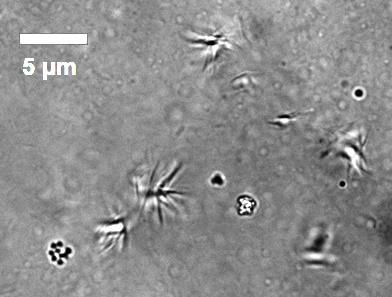Communication and waterproofing: Biology and physics come together in an interdisciplinary project to investigate the physical properties of wax-like cuticular hydrocarbons

Credit: photo/©: Bérengère Abou
As social insects, ants are particularly dependent on optimizing their communication in order to ward off enemies and to recognize individuals from their own colony. They must also protect themselves against desiccation. Their bodies are covered with wax-like substances known as cuticular hydrocarbons (CHCs) that serve both purposes – communication and protection against desiccation. However, while recognition of other ants requires the CHC layer to be not too solid, making it easier for other ants to sense the chemical signals in the layer, desiccation protection requires it to be as solid as possible. To resolve this conflict between the needs of communication and waterproofing, this layer is composed of CHCs with special physical properties, as biologists have now discovered. “We were surprised to find that the layer does not melt at a specific temperature or a narrow temperature range, but rather has a huge melting range: It starts melting at around minus 45 degrees Celsius and is only fully liquid above 30 to 40 degrees Celsius,” explained Dr. Florian Menzel of Johannes Gutenberg University Mainz (JGU). “We found that the layer is, in fact, composed of a mixture of liquid and solid components, similar to ice cubes in a glass of water or liquid honey containing sugar crystals.”
Conflicting functions: communication versus waterproofing
The CHC layer covering the bodies of almost all insects like an external skin has already been studied in detail. For instance, scientists already know that CHCs form a mixture of several dozens to over a hundred different compounds and that each species of ant has its own distinctive hydrocarbon blend. The chemical composition of the hydrocarbons determines not only their information content, but it also influences how well the layer prevents desiccation. “In other words, the substances have to serve different purposes simultaneously, which can, of course, be a problem,” said Menzel.
Along with chemist Dr. Svenja Morsbach of the Max Planck Institute for Polymer Research in Mainz and physicist Dr. Bérengère Abou of the Centre national de la recherche scientifique (CNRS) in Paris, Menzel has now studied the physical properties of this wax-like layer, in particular the melting ranges of the hydrocarbons and their flow characteristics. To date, neither has been an issue in research.
Viscosity similar to that of motor oil
Finding suitable methods for investigating such tiny quantities of material was particularly challenging. Based on a formula developed by Albert Einstein, Abou had developed a novel microrheological technique to measure viscosity in this case, which allows to measure liquid drops as tiny as 100 pikoliters. The viscosity of the CHC layer was found to be similar to that of motor oil. Although the investigated hydrocarbon mixtures were completely different from each other – the CHCs of eleven different ant species were included in the study -, the viscosity was very similar for all species. The research team attributes this similarity to the fact that the exchange of communication signals may require a specific degree of viscosity or fluidity.
The chemical composition of the wax layer alone does not predict its waterproofing ability
Scientists at the Max Planck Institute for Polymer Research employed differential scanning calorimetry (DSC) to determine the melting behavior of the hydrocarbons. “We were astonished by the results. To date, this aspect has been largely neglected, while numerous studies implicitly assumed that the CHC layer is completely solid at ambient temperatures,” said Menzel. Over the entire melting range, between minus 45 degrees Celsius and plus 40 degrees Celsius, the hydrocarbons take the form of a blend of liquid and solid components. According to Menzel, this liquid-solid mixture is essential to allow the CHC layer to fulfill both purposes. “There might be a fundamental conflict between the two functions of waterproofing and communication, which makes the evolution of CHCs particularly intriguing,” the biologist added. If this is the case, the melting behavior of the CHCs, which directly depends on their chemical composition, would be one of the most important functional characteristics of the waxy CHC layer. It determines how effectively the CHC layer inhibits desiccation at different temperatures, while at the same time influencing how signals are exchanged. This not only applies to ants but most likely also to nearly all other insects.
Menzel and his team now plan to investigate how the viscosity and melting behavior of hydrocarbons change when ants can acclimate to different temperatures over several weeks. Insects may rely on such acclimation strategies to survive temperature fluctuations that are associated with a higher risk of desiccation.
###
Media Contact
Dr. Florian Menzel
[email protected]
49-613-139-27848
Original Source
https:/
Related Journal Article
http://dx.




